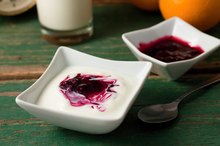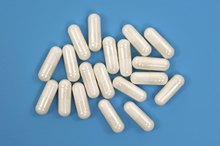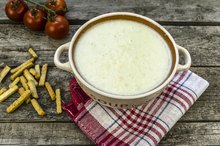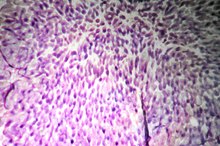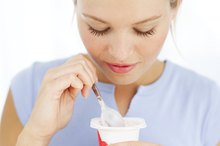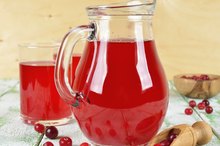Foods Good to Eat for an Ulcer
Approximately 20 million Americans will develop an ulcer over their lifetimes, the University of Maryland Medical Center reports 1. These open sores form on the inside lining of your gastrointestinal tract -- along the esophagus, stomach or small intestine. While it is a common misconception that eating spicy foods can cause an ulcer, the condition is actually the result of bacteria known as Helicobacter pylori. A diet for an ulcer emphasizes eating easily digested, mild-flavor foods and avoiding foods that cause irritation and inflammation in your digestive tract.
Ulcer Basics
A burning pain is the most commonly associated symptom of an ulcer. This pain may be worse during the night or when you lie down. It may also flare when your stomach is empty, go away temporarily and even be relieved by antacid medications. You may also experience weight loss, appetite changes, nausea or vomiting, heartburn, indigestion or belching. Seek medical attention if these symptoms persist or worry you.
- A burning pain is the most commonly associated symptom of an ulcer.
- This pain may be worse during the night or when you lie down.
Offending Bacteria
Non-Dairy Probiotic Drinks
Learn More
Helicobacter pylori is a bacteria found naturally in the tissues of the stomach and small intestine 3. While researchers believe that this bacteria may have protective health benefits, it is known to cause infection. According to the National Digestive Disease Information Clearinghouse, H. pylori can damage the mucous coating that protects the stomach and duodenum 2. This damage allows stomach acids to get through to the sensitive lining beneath. Together, the H. pylori and stomach acid irritate the lining of the digestive tract and cause an ulcer to form 2.
Probiotic Treatment
One treatment for H. pylori-related ulcers is antibiotics, which have proved to be 90 percent effective. The downfall is that they are expensive and can cause antibiotic resistance. Thus, probiotics have been researched as a viable alternative. The "Journal of Nutrition" compiled data to determine the effectiveness of probiotics in reducing gastric inflammation and treating H. pylori 3. The journal found that seven out of nine studies showed an improvement of H. pylori density and the reduced risk of developing inflammatory disorders after the administration of probiotics 3.
- One treatment for H. pylori-related ulcers is antibiotics, which have proved to be 90 percent effective.
Probiotic Foods
The Nutrition in Raw Kefir
Learn More
Probiotics are available as a supplement or in certain foods. These foods include:
- milk
- yogurt
- kombucha
- miso soup
- kefir
- sauerkraut
- dark chocolate
- soy milk
- olives
- tempeh
- pickles
Choose yogurt varieties that contain live or active cultures and do not have added sugar or syrups for best results. Kombucha, or fermented tea, is a staple in Asian grocery stores and can be served hot or cold. It is a dark tea that enhances digestion. Tempeh is a soy protein rich in probiotics and eaten as a meat alternative; it can be grilled, sauteed or baked. Miso soup, a combination of vegetable broth and tofu, is high in protein and probiotics. Available at most health food stores, microalgae, also called blue algae, is a grassy, green plant used in juice.
- Probiotics are available as a supplement or in certain foods.
- Tempeh is a soy protein rich in probiotics and eaten as a meat alternative; it can be grilled, sauteed or baked.
Related Articles
References
- University of Maryland Medical Center: Peptic Ulcer
- National Digestive Disease Information Clearinghouse: H. pylori and Peptic Ulcers
- Journal of Nutrition: Helicobacter Pylori and Probiotics
- Reader’s Digest: 13 Probiotic-Filled Foods
- Wroblewski LE, Peek RM Jr, Wilson KT. Helicobacter pylori and gastric cancer: factors that modulate disease risk. Clin Microbiol Rev. 2010;23(4):713–739. doi:10.1128/CMR.00011-10
- Marcus EA, Sachs G, Scott DR. Eradication of Helicobacter pylori Infection. Curr Gastroenterol Rep. 2016;18(7):33. doi:10.1007/s11894-016-0509-x
- Eusebi LH, Zagari RM, Bazzoli F. Epidemiology of Helicobacter pylori infection. Helicobacter. 2014;19 Suppl 1:1-5. doi:10.1111/hel.12165
- National Institute of Diabetes and Digestive and Kidney Diseases. Symptoms & Causes of Gastritis & Gastropathy. Updated August 2019.
- Eichenseher J. Peptic Ulcer Disease. Integrative Medicine. 2018. doi:10.1016/b978-0-323-35868-2.00043-8.
- National Institute of Diabetes and Digestive and Kidney Diseases. Symptoms & Causes of GI Bleeding. Updated July 2016.
- National Cancer Institute. Helicobacter pylori and Cancer. Updated September 5, 2013.
- American Cancer Society. Signs and Symptoms of Stomach Cancer. Updated December 14, 2017.
- Pilotto A, Franceschi M. Helicobacter pylori infection in older people. World J Gastroenterol. 2014;20(21):6364–6373. doi:10.3748/wjg.v20.i21.6364
- National Institute of Diabetes and Digestive and Kidney Diseases. Upper GI Endoscopy. Updated July 2017.
- Lender N, Talley NJ, Enck P, et al. Review article: Associations between Helicobacter pylori and obesity--an ecological study. Aliment Pharmacol Ther. 2014;40(1):24-31. doi:10.1111/apt.12790
- Chung WC, Jeon EJ, Lee KM, et al. Incidence and clinical features of endoscopic ulcers developing after gastrectomy. World J Gastroenterol. 2012;18(25):3260–3266. doi:10.3748/wjg.v18.i25.3260
Resources
Writer Bio
Erica Wickham covers health, exercise and lifestyle topics for various websites. She completed an internship in dietetics and earned a Master of Science in dietetics from D’Youville College in Buffalo, N.Y. Wickham now serves as a registered dietitian.

